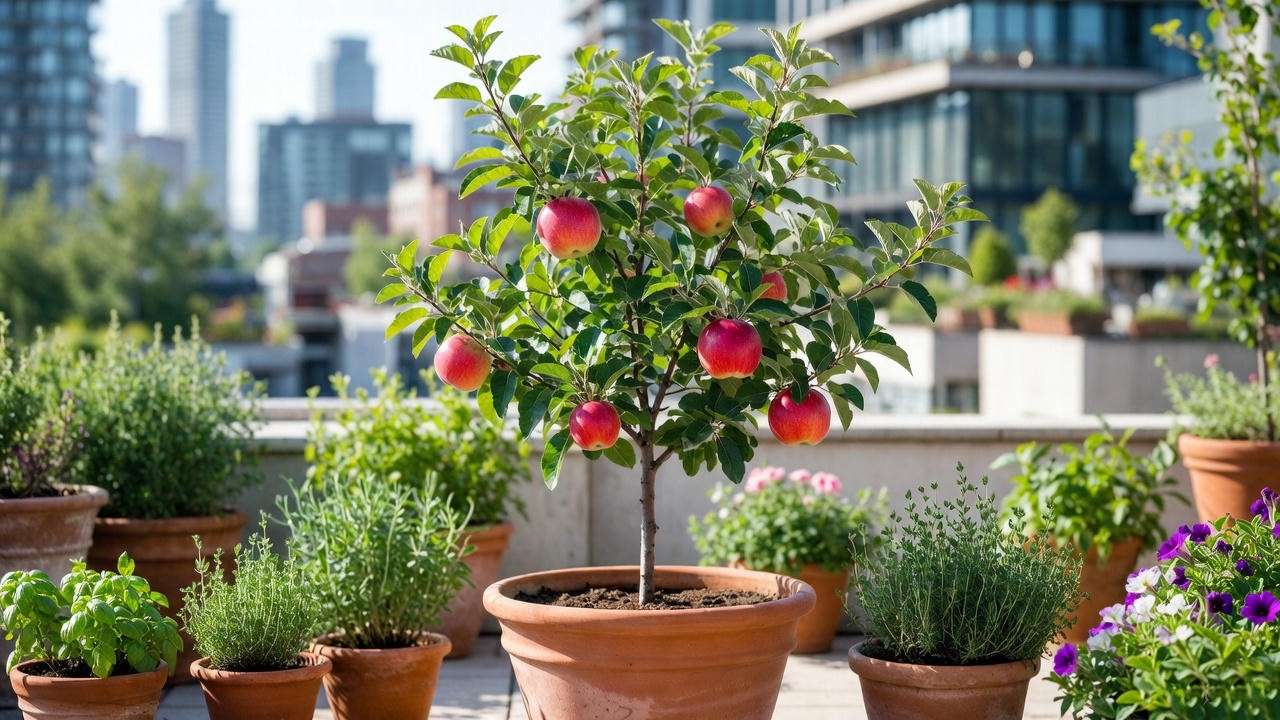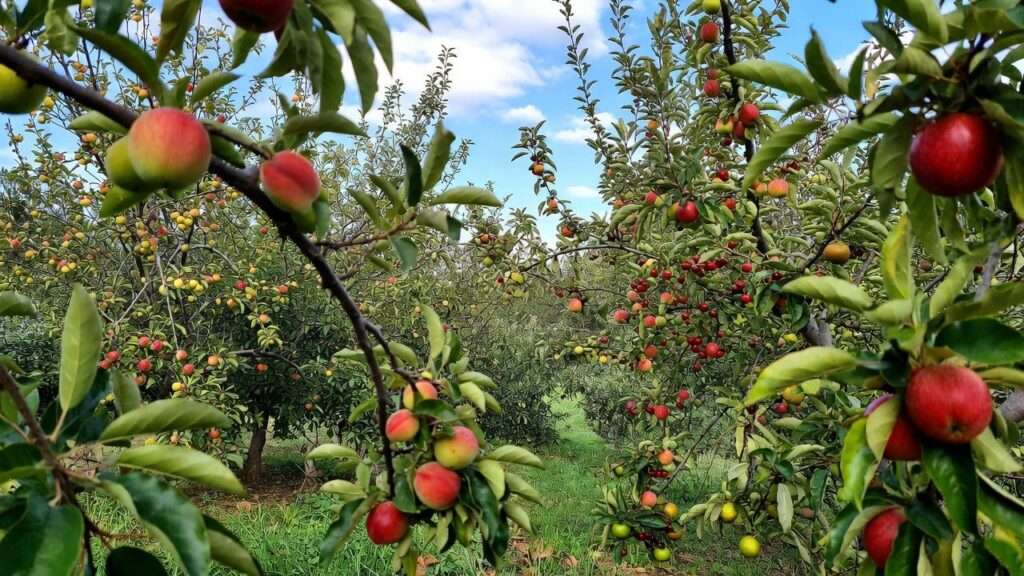Picture this: a backyard bursting with ripe, juicy fruit—apples, peaches, cherries—all from a single tree that thrives without complex pollination tricks. Self-pollinating fruit trees are the secret weapon for gardeners craving fresh, homegrown produce with minimal effort. Whether you’re a beginner with a tiny patio or a seasoned gardener with a sprawling yard, these trees deliver abundant harvests without needing a second tree for cross-pollination. In this guide, we’ll explore the top 10 self-pollinating fruit trees, share expert growing tips, and empower you to create a low-maintenance orchard that yields delicious results. Written by a horticultural expert with over a decade of experience in fruit tree cultivation, this article draws on research from leading agricultural institutions and real-world gardening success stories to ensure you get practical, trustworthy advice. Ready to grow your own fruit? Let’s dive in!
What Are Self-Pollinating Fruit Trees? 🌸
Understanding Self-Pollination in Fruit Trees
Self-pollinating fruit trees, also known as self-fertile trees, are varieties that produce fruit without requiring pollen from another tree. These trees have “perfect” flowers, meaning they contain both male and female parts, allowing them to pollinate themselves. In some cases, their pollen is self-compatible, meaning it can fertilize the tree’s own flowers to produce fruit. This makes them a fantastic choice for gardeners who want simplicity and efficiency in their orchards.
Unlike cross-pollinating trees, which need a compatible variety nearby to bear fruit, self-pollinating trees are standalone producers. For example, a single self-pollinating peach tree can yield dozens of peaches without a second tree. This trait is especially valuable for urban gardeners, small-space growers, or anyone looking to minimize maintenance.
Why Choose Self-Pollinating Trees?
Self-pollinating fruit trees offer a host of benefits:
- Space-Saving: Perfect for small yards, patios, or even containers.
- Cost-Effective: No need to buy multiple trees for pollination.
- Beginner-Friendly: Less complexity for first-time gardeners.
- Reliable Yields: Consistent fruit production, even without nearby pollinators.
For instance, a single ‘Stella’ cherry tree can produce up to 50 pounds of sweet cherries, making it a favorite for home growers. Whether you’re dreaming of fresh pies or homemade jams, these trees make it easy to achieve your goals.
Top 10 Self-Pollinating Fruit Trees for Your Garden 🍑
Here’s our expertly curated list of the top 10 self-pollinating fruit trees, each chosen for its ease of growth, reliable yields, and delicious fruit. Each section includes growing tips, harvest expectations, and expert insights to help you succeed.
1. Peach Trees (Prunus persica) 🍑
Why They’re Great: Peaches are a summer favorite, offering sweet, juicy fruit perfect for eating fresh, canning, or baking into pies. Self-pollinating varieties like ‘Redhaven’ and ‘Elberta’ are compact, making them ideal for small gardens.
Growing Tips: Plant in full sun (6–8 hours daily) with well-drained, slightly acidic soil (pH 6.0–6.5). Prune annually to maintain an open canopy for airflow and fruit production. Water deeply during dry spells.
Harvest Expectations: A mature peach tree can yield 30–50 pounds of fruit per season.
Expert Insight: Watch for peach leaf curl, a common fungal disease. Apply organic copper-based fungicides in early spring to prevent it.

2. Nectarine Trees (Prunus persica var. nucipersica) 🍑
Why They’re Great: Nectarines, essentially fuzz-free peaches, deliver vibrant flavors and smooth skins. Varieties like ‘Fantasia’ and ‘Snow Queen’ are self-fertile and thrive in warm climates.
Growing Tips: Choose a sunny, sheltered spot to protect from late frosts. Water consistently during fruit development, and use mulch to retain moisture.
Harvest Expectations: Expect 20–40 pounds of nectarines from a mature tree.
Expert Insight: Nectarines are susceptible to the same pests as peaches, like aphids. Introduce beneficial insects like ladybugs for natural pest control.
3. Apple Trees (Malus domestica) 🍎
Why They’re Great: Apples are versatile for eating fresh, baking, or making cider. Self-pollinating varieties like ‘Gala’ and ‘Honeycrisp’ (partially self-fertile) produce reliable crops, though yields improve with nearby pollinators.
Growing Tips: Plant in well-drained soil with full sun. Dwarf varieties are perfect for patios, growing 6–10 feet tall. Ensure 500–1000 chilling hours (below 45°F) for fruit set.
Harvest Expectations: A dwarf apple tree yields 20–40 apples, while standard trees can produce 100+ pounds.
Pro Tip: Pair with a crabapple tree to boost pollination and yields.
4. Cherry Trees (Prunus avium) 🍒
Why They’re Great: Sweet cherries like ‘Stella’ and ‘Lapins’ are self-pollinating, offering juicy fruit and compact growth for small spaces.
Growing Tips: Plant in well-drained soil with full sun. Protect fruit from birds using netting. Prune in late winter to encourage new growth.
Harvest Expectations: A mature ‘Stella’ cherry tree can yield up to 50 pounds of fruit.
Example: Home gardeners love ‘Lapins’ for its large, dark cherries, perfect for snacking or preserves.

5. Plum Trees (Prunus domestica) 🍇
Why They’re Great: Plums, like ‘Santa Rosa’ and ‘Methley’, offer juicy fruit and stunning spring blossoms, doubling as ornamental trees.
Growing Tips: Plant in full sun with loamy soil. Prune to maintain an open structure and prevent disease. Water moderately but consistently.
Harvest Expectations: Expect 20–50 pounds of plums per tree.
Fun Fact: Plums are packed with antioxidants, making them a healthy addition to your garden.
6. Apricot Trees (Prunus armeniaca) 🍑
Why They’re Great: Apricots, such as ‘Moorpark’ and ‘Tilton’, produce sweet-tart fruit and are drought-tolerant, making them ideal for sunny, dry regions. Their self-pollinating nature ensures reliable yields without extra trees.
Growing Tips: Plant in a warm, sunny location with well-drained soil (pH 6.0–7.0). Protect from late spring frosts, which can damage blossoms. Water deeply but infrequently once established.
Harvest Expectations: A mature apricot tree can yield 20–40 pounds of fruit per season.
Expert Insight: Apricots thrive in Mediterranean climates. For colder regions, choose frost-resistant varieties like ‘Tilton’ and use frost blankets during early spring.
7. Fig Trees (Ficus carica) 🍈
Why They’re Great: Figs, like ‘Brown Turkey’ and ‘Celeste’, are low-maintenance and don’t require pollination for most varieties, as they produce parthenocarpic fruit (fruit without fertilization). They’re perfect for warm climates and container gardening.
Growing Tips: Plant in full sun with well-drained soil. Figs are drought-tolerant but benefit from regular watering during fruit development. Prune lightly to maintain shape.
Harvest Expectations: Expect 10–20 pounds of figs per season from a mature tree.
Pro Tip: Grow figs in pots in cooler climates and bring them indoors during winter to extend their growing season.
8. Pear Trees (Pyrus communis) 🍐
Why They’re Great: Pears, such as ‘Moonglow’ and ‘Bartlett’, are self-pollinating and produce sweet, juicy fruit with a long storage life, perfect for fresh eating or canning.
Growing Tips: Choose a sunny spot with well-drained, fertile soil. Ensure good air circulation to prevent fire blight, a common bacterial disease. Water consistently during fruit set.
Harvest Expectations: A mature pear tree can yield 30–50 pounds of fruit.
Expert Insight: ‘Moonglow’ is resistant to fire blight, making it a top choice for humid regions.
9. Citrus Trees (Citrus spp.) 🍊
Why They’re Great: Citrus trees, like ‘Meyer Lemon’ and ‘Satsuma Orange’, are self-pollinating and thrive in warm climates or containers, offering year-round fruit in ideal conditions.
Growing Tips: Plant in acidic, well-drained soil (pH 5.5–6.5) with full sun. Protect from frost with blankets or by moving potted trees indoors. Fertilize monthly during the growing season.
Harvest Expectations: A mature citrus tree can produce 50–100 fruits per season, depending on the variety.
Example: ‘Meyer Lemon’ is a favorite for urban gardeners, yielding tangy, sweet lemons perfect for desserts or drinks.
10. Persimmon Trees (Diospyros kaki) 🍅
Why They’re Great: Persimmons, such as ‘Fuyu’ and ‘Hachiya’, offer sweet, unique fruit and are low-maintenance with minimal pest issues. Their vibrant fall foliage adds ornamental value.
Growing Tips: Plant in full sun with well-drained soil. Water moderately, especially during fruit development. Prune lightly to maintain structure.
Harvest Expectations: A mature persimmon tree can yield 20–40 pounds of fruit.
Fun Fact: ‘Fuyu’ persimmons are non-astringent, meaning you can eat them fresh off the tree, unlike astringent varieties like ‘Hachiya’ that need to ripen fully.
How to Choose the Right Self-Pollinating Fruit Tree for Your Garden 🌍
Selecting the perfect self-pollinating fruit tree depends on your climate, space, and fruit preferences. Here’s how to make an informed choice.
Factors to Consider Before Planting
- Climate and USDA Hardiness Zones: Match your tree to your region’s climate. Citrus and figs thrive in zones 8–10, while apples and pears suit zones 4–8. Check your zone via the USDA Plant Hardiness Zone Map.
- Space Availability: Dwarf varieties (6–10 feet tall) are ideal for patios or small yards, while standard trees (15–30 feet) suit larger spaces.
- Soil Type and Drainage: Most fruit trees need well-drained, loamy soil. Test your soil’s pH and amend with compost or sulfur as needed.
- Fruit Preferences: Choose based on how you’ll use the fruit—fresh eating (apples, cherries), preserves (plums, apricots), or cooking (pears, figs).
Space-Saving Options for Small Gardens
Dwarf and semi-dwarf varieties are game-changers for urban gardeners. For example:
- A dwarf ‘Gala’ apple tree fits on a balcony and yields 20–30 apples.
- Citrus trees like ‘Meyer Lemon’ thrive in pots, producing fruit year-round in warm climates.
- Figs like ‘Brown Turkey’ are container-friendly and require minimal pruning. Pro Tip: Use large, well-draining pots (15–20 gallons) for container trees and ensure adequate sunlight.

Climate Compatibility
- Warm Climates (Zones 8–10): Citrus, figs, and persimmons excel in hot, sunny regions.
- Cooler Climates (Zones 4–7): Apples, pears, and cherries are cold-hardy and tolerate frost.
- Expert Insight: Contact your local cooperative extension service for region-specific recommendations. For example, the University of California’s extension program offers detailed guides for fruit tree cultivation in Mediterranean climates.
Planting and Caring for Self-Pollinating Fruit Trees 🌿
Step-by-Step Planting Guide
- Timing: Plant in early spring or fall when temperatures are mild, allowing roots to establish before extreme heat or cold.
- Site Selection: Choose a spot with full sun (6–8 hours daily) and well-drained soil. Avoid low-lying areas where water pools.
- Planting Process:
- Dig a hole twice as wide and as deep as the root ball.
- Loosen the roots and place the tree at the same depth it was in the nursery pot.
- Backfill with a mix of native soil and compost, then water thoroughly.
- Stake young trees to protect against wind.
- Pro Tip: Add a 2–3-inch layer of organic mulch (e.g., wood chips) around the base to retain moisture and suppress weeds, keeping it 2 inches from the trunk to prevent rot.
Essential Care Tips for Maximum Yields
- Watering: Water deeply but infrequently, providing 1–2 inches per week for young trees. Established trees need less frequent watering, except during drought.
- Fertilizing: Apply a balanced NPK fertilizer (e.g., 10-10-10) in early spring before bud break. Avoid over-fertilizing, which can lead to excessive leaf growth at the expense of fruit.
- Pruning: Prune annually in late winter or early spring to remove dead wood, improve airflow, and encourage fruiting branches. For example, peach trees benefit from an open-center shape to maximize sunlight exposure.
- Pest and Disease Management: Use organic solutions like neem oil for aphids or sulfur sprays for fungal issues. Monitor for common problems like fire blight (pears) or peach leaf curl.

Common Mistakes to Avoid
- Overwatering: Leads to root rot, especially in poorly drained soils. Use a moisture meter to check soil conditions.
- Improper Pruning: Cutting too much or at the wrong time can reduce yields. Follow variety-specific pruning guides from sources like Cornell University’s horticulture department.
- Ignoring Soil pH: Most fruit trees prefer slightly acidic soil (pH 6.0–7.0). Test your soil annually and amend with lime (to raise pH) or sulfur (to lower pH).
Maximizing Your Harvest: Expert Tips and Tricks 🚀
To ensure your self-pollinating fruit trees produce bountiful harvests, follow these expert strategies to optimize growth and fruit quality.
Boosting Fruit Production
- Thinning Fruit: Remove excess young fruit to improve the size and quality of the remaining harvest. For example, thin peaches to one fruit every 6–8 inches along the branch to prevent overloading the tree.
- Pollinator Attraction: While self-pollinating trees don’t require external pollinators, attracting bees and other beneficial insects can enhance yields. Plant pollinator-friendly flowers like lavender or marigolds nearby to draw bees.
- Mulching: Apply a 2–3-inch layer of organic mulch (e.g., bark or straw) around the tree’s base to retain moisture, regulate soil temperature, and reduce weeds. Keep mulch away from the trunk to avoid rot.
- Expert Insight: According to the University of California’s Cooperative Extension, consistent thinning can increase fruit size by up to 20% and reduce stress on the tree, leading to healthier long-term production.

Seasonal Care Calendar
A well-timed care routine ensures your trees thrive year-round. Here’s a seasonal guide:
- Spring: Fertilize with a balanced NPK fertilizer as buds form. Prune to remove dead or crowded branches. Monitor for early pests like aphids and apply organic controls as needed.
- Summer: Water consistently, especially during fruit development. Thin fruit to improve quality. Check for signs of disease, such as powdery mildew, and treat promptly.
- Fall: Harvest ripe fruit and clean up fallen leaves to prevent pests and diseases from overwintering. Apply a light layer of compost to enrich the soil.
- Winter: Protect young trees from frost with blankets or burlap. Plan for the next season by ordering new varieties or pruning tools.
- Pro Tip: Keep a gardening journal to track bloom times, harvest yields, and pest issues. This helps you refine your care routine over time.
FAQs About Self-Pollinating Fruit Trees ❓
Here are answers to common questions gardeners ask about self-pollinating fruit trees, based on real-world experience and horticultural research:
- Q: Do self-pollinating trees need bees?A: While bees can boost fruit set by aiding pollination, most self-pollinating trees produce fruit without them. For example, ‘Stella’ cherries and ‘Meyer Lemon’ citrus trees reliably yield without insect pollinators, though bee activity may increase output.
- Q: Can I grow self-pollinating trees in pots?A: Yes, dwarf varieties like ‘Meyer Lemon’, ‘Brown Turkey’ fig, and ‘Gala’ apple thrive in containers. Use 15–20-gallon pots with well-draining soil and ensure 6–8 hours of daily sunlight.
- Q: How long until my tree produces fruit?A: Most self-pollinating fruit trees bear fruit in 2–5 years, depending on the variety and growing conditions. Dwarf trees often fruit sooner (2–3 years), while standard trees may take 4–5 years.
- Q: Are self-pollinating trees completely self-sufficient?A: While they don’t need a second tree for pollination, they require proper care—watering, fertilizing, pruning, and pest management—to produce optimal yields. Neglecting these can reduce fruit quality or quantity.
Conclusion: Start Growing Your Own Fruit Today! 🌟
Self-pollinating fruit trees are a gardener’s dream: easy to grow, space-efficient, and packed with delicious rewards. From the sweet juiciness of peaches to the tangy zest of Meyer lemons, the 10 trees highlighted in this guide offer something for every climate, space, and taste. By choosing the right variety for your region, following our expert planting and care tips, and avoiding common mistakes, you’ll be harvesting homegrown fruit in just a few seasons. Whether you’re a beginner or a seasoned grower, these low-maintenance trees make it simple to create a thriving backyard orchard.
Ready to get started? Pick one or two trees from our list, plant them with care, and watch your garden transform into a fruitful paradise. Share your gardening journey in the comments below or on social media—we’d love to hear about your harvests! With self-pollinating fruit trees, you’re just a few steps away from a bountiful orchard—no green thumb required!













